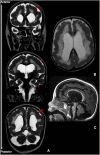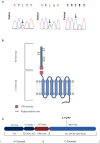Case Report: Diffuse Polymicrogyria Associated With a Novel ADGRG1 Variant
- PMID: 34513772
- PMCID: PMC8430206
- DOI: 10.3389/fped.2021.728077
Case Report: Diffuse Polymicrogyria Associated With a Novel ADGRG1 Variant
Abstract
Pathogenic variants of the ADGRG1 gene are associated with bilateral frontoparietal polymicrogyria, defined radiologically by polymicrogyria with an anterior-posterior gradient, pontine and cerebellar hypoplasia and patchy white matter abnormalities. We report a novel homozygous ADGRG1 variant with atypical features. The patient presented at 8 months of age with motor delay, esotropia, hypotonia with hyporeflexia and subsequently developed refractory epilepsy. At the last assessment, aged 12 years, head control, sitting and language were not acquired. Magnetic resonance imaging revealed diffuse polymicrogyria with relative sparing of the anterior temporal lobes, without an anterior-posterior gradient, diffuse hypomyelination and pontine and cerebellar hypoplasia. A panel targeting brain morphogenesis defects yielded an unreported homozygous ADGRG1 nonsense variant (dbSNP rs746634404), present in the heterozygous state in both parents. We report a novel ADGRG1 variant associated with diffuse polymicrogyria without an identifiable anterior-posterior gradient, diffuse hypomyelination and a severe motor and cognitive phenotype. Our case highlights the phenotypic diversity of ADGRG1 pathogenic variants and the clinico-anatomical overlap between recognized polymicrogyria syndromes.
Keywords: ADGRG1; GPR56; bilateral frontoparietal polymicrogyria; bilateral generalized polymicrogyria; case report; polymicrogyria.
Copyright © 2021 Carneiro, Duarte, Laranjeira, Barbosa-Gouveia, Couce and Fonseca.
Conflict of interest statement
The authors declare that the research was conducted in the absence of any commercial or financial relationships that could be construed as a potential conflict of interest.
Figures



References
Publication types
LinkOut - more resources
Full Text Sources

